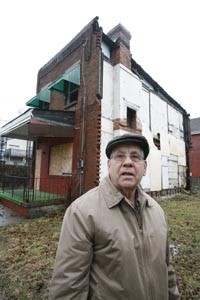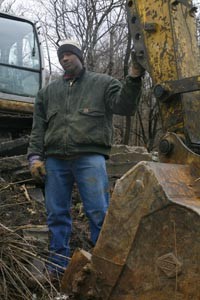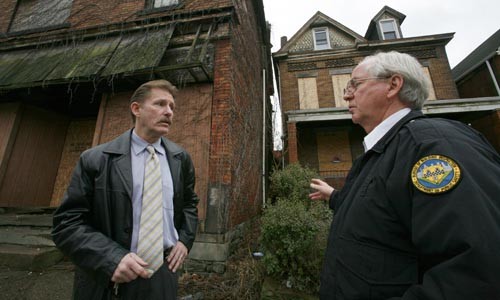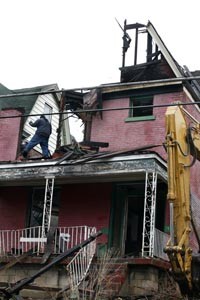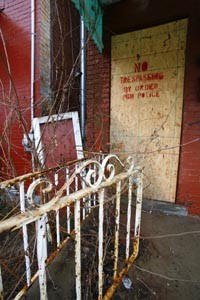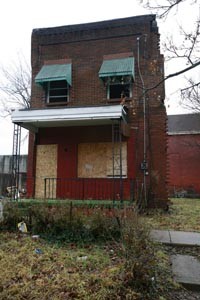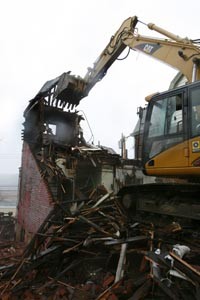There's a row house in Hazelwood whose days -- like those of dozens of other homes nearby -- are numbered. Two of its three front windows are dark and missing glass. Bricks have fallen from the top of its right side. The left side has no exterior wall at all.
The house that used to be next door is already missing, giving the block the punched-out look of a hockey player's smile.
The back door is wide open; someone has piled garbage next to it, and a track of footprints in the February snow suggest a recent visitor.
Inside, though, are only the scattered possessions of former inhabitants. On the first floor there's a December 2007 calendar nailed to a wall, a mound of Tupperware on the floor. Upstairs, there's a gift basket with some deodorant and a handmade "I <3 You Dad" button. Beside the basket is a box full of baseball cards. There are photos, too: a wedding and camping trips, five young men standing shirtless in front of a river. There's a tackle-box with a flask of gun oil in it, and a prescription bottle for the painkiller Hydrocodone.
Sometime in the next few months, even these traces will be gone. The house itself will be torn down; the wreckage, and what little remains inside it, will be trucked off to a landfill. The home's foundation will be filled with mud, left for weeds and grass to claim.
This house is one of the almost 60 Hazelwood homes scheduled to be removed as part of a demolition "blitz." For years, vacant homes like this one have sat in Hazelwood and throughout the city, condemned but never removed. They stand as reminders of the much larger city that Pittsburgh once was -- and symbols of the challenges it faces today: a surplus of housing that represents fire hazards, blight and dens for criminal activity.
The goal of the blitz -- for which the city has doubled its demolition budget -- is to target individual neighborhoods, hitting them with a slew of demolitions in a relatively short time. "[A vacant home] is an area where crime can and does develop," Mayor Luke Ravenstahl said at a Feb. 19 seminar on demolition. "It's a blight to the eye, but it's also a public-safety issue."
At best, though, demolition is a partial solution -- a quick answer to a crisis that has been years in the making. For long-suffering neighborhoods like Hazelwood, it is easier to tear down than to rebuild.
"We have problems here," says Alexander Jozsa Bodnar, a Hazelwood resident and owner of Josza's Corner restaurant. "You heard all the horror stories: Who the hell would want to set up here?"
From the time the first white settlers arrived in Hazelwood, the area has been haunted by traces of its former occupants. According to a 1972 history published in Carnegie Magazine, the area was dotted with Indian burial mounds. But the early Scots-Irish who settled the area -- which was known for a time as "Scotch Bottom" -- were unsentimental about the ruins. The burial mounds, wrote Jerry Vondas, were built large enough that "when the first settlers finally demolished them, there were enough stones to pave the old Indian trail that was later to become Second Avenue."
For a time, Hazelwood was a genteel place, lined with stately homes owned by riverboat captains and other prosperous citizens. But as the 19th century progressed, the river attracted industry, and industry attracted new generations of workers from Eastern Europe and elsewhere. Hazelwood became a key link in the Baltimore & Ohio Railroad, which operated a roundhouse and other facilities. It also housed a portion of the Jones & Laughlin Pittsburgh Works, a massive steelmaking complex that sprawled along both sides of the Monongahela River. The mill attracted workers, who built a self-sustaining, if somewhat gritty, community nearby.
There was a time when "[y]ou didn't have to leave here," recalls Suzanne Murray, as she bounces her great-grandson, a seventh-generation Hazelwood resident, on her knee. "It was dirty: You couldn't keep this place clean. But it didn't bother us."
Murray lives in her great-grandmother's 110-year-old house. Her father worked at J&L, and Murray herself was lucky enough to live through some of the golden years: "This place was booming, I bet you, in the '50s and '60s," she says.
"We used to have a lot of fun over here. It used to be good family living," agrees Saverio Strati, a Hazelwood resident for more than 50 years. Originally a stoneworker by trade, Strati moved here from Italy after a five-year stay in Canada. Hazelwood, he recalls, "was one of the most desirable [neighborhoods] for the labor force."
Strati says there were thousands of jobs to be had with J&L and B&O. He himself ended up in a J&L warehouse, where he climbed from laborer to repairman to machinist.
Back then, Hazelwood had a movie theater and a bowling alley, not to mention a supermarket and variety stores. Now, Murray does her shopping at the Waterfront Giant Eagle. The closest bowling alley is in Squirrel Hill.
"We had a mass of people moving away after the mills started to shut down in the late '70s, early '80s," Strati says. "With the kids growing up, and the mills slowing down, the young people started to move away. The older people started passing away and the young kids don't come back."
As the population continued to slide, local businesses closed. "It was rough in the late '80s and early '90s," Strati recalls. In the 1990s alone, the neighborhood lost over 1,100 residents -- roughly 15 percent of its population, according to the Hazelwood Initiative, a community-redevelopment group.
Fran Bertonaschi, a Hazelwood Initiative board member, says that when he moved into the neighborhood in 1986, it was still on the decline.
"The mill down here was still going, but it had scaled down," he says. The coke works -- where coal was transformed into a fuel for steelmaking -- was the last part of the mill to close, and at times a sulfurous haze from the plant would permeate the neighborhood. Even people who worked in the mills moved away as they got better paid, Bertonaschi says.
"Houses started getting hard to maintain. The town changed. More and more houses became empty," Strati says. "We used to be a neighborhood. That's not the case anymore.
"The kids can only find recreation on the streets. And for years it's been like that. Nobody had the guts to do anything."
For Strati, Hazelwood's last, best hope died with Mayor Bob O'Connor, who took the city's helm after representing Hazelwood and nearby communities on City Council. He remembers the mayor, who served for less than a year before dying of brain cancer, telling him, "I know Hazelwood has been neglected for a long time. If I get elected, we're going to put Hazelwood on the right track."
"The way he passed away, that hope went away."
But for restaurant owner Alex Bodnar, the trouble started long before O'Connor's death. The seeds for Hazelwood's current despair, he says, were already being planted in the days of its triumph.
"We allowed the industrialists to take over," he says. "Yeah, they provided jobs, but they left." And while it's easy to wax nostalgic about the days when Pittsburgh's population was roughly twice its current size, in Hazelwood it's still possible to see the dangers of packing so many employees so close together.
"You cannot set up homes in such a fashion, when the supposed firewalls were no firewalls," Bodnar says. If fire struck one home, "[i]t burned straight through." In January 2007, for example, a fire that was started in a vacant Hazelwood house burned through 12 row houses, displacing two dozen people and sending one man to the hospital in critical condition. That blaze, in fact, "brought Hazelwood front and center" on the city's list of priorities for demolition, says Michael Huss, the city's director of public safety and formerly its fire chief.
Hazelwood has also been living in the shadow of the Mon-Fayette Expressway, a toll-road project that has been on drawing boards for a half-century, but whose critical Pittsburgh-to-Route 51 portion remains unbuilt for lack of funding. "Since the '60s, they've been talking about building this highway," Strati explains. "Some people still don't know where it's going to go. People don't put money to maintain their own property because they think the highway is going to take everything."
In between dirty jokes (in English and Hungarian), Bodnar tells horror stories from the area's more recent past, when prostitution and drug peddling replaced legitimate businesses. Perhaps most famously, Terrance Cole was sentenced to life in prison in March 2006 for running a multimillion dollar cocaine ring out of Hazelwood. "Our area was starting to be well known for selling dope," Bodnar says.
Bodnar says his own Hazelwood home has been broken into. The windows of his restaurant have been battered.
"Do you think the police give a flying rat's ass?" he asks. "I'm living on an island."
On the counter of his restaurant, Bodnar has a copy of the 15th Ward Chamber of Commerce's first annual phone-directory booster book. On one of its first pages there's a letter from Bodnar, calling for change and revitalization.
"You saw the date?" he now yells. "'86! What the hell has happened since?"
From the looks of things, very little. Some of Hazelwood's abandoned homes have cracked windows or missing doors. The city boards up some condemned properties, but even then it's not uncommon to find that someone has yanked a board from its place.
"They should have taken them down a lot earlier because it wouldn't have had a chance to gather all these kinds of people, buying and selling," Strati says. "It wouldn't have rooted."
Many of the structures are in such bad shape that rehabilitation would cost more than the property is worth.
"Who wants to look at a big vacant lot, but who wants to look at some of the houses that are out there?" Murray asks.
Like many of those homes, "Hazelwood is basically a shell at this point," Bodnar concludes. "Now we're in limbo. Even some of the community organizers and community heads don't want to face up to [it.] This is a shell of a community."
Kurt Rouse is knocking down those shells as fast as he can. The 46-year-old works as site manger for ROAC, Inc., a family-owned demolition company that won the bid to knock down 57 houses in Hazelwood.
Using an excavator -- a cabin on two tank-like tracks with a long arm attached to a shovel -- one of ROAC's operators pulls down the second of three houses in a row. Rouse and another laborer look on. It's Tuesday morning, March 4. The wood cracks, and the walls come down as the sound of splintering fills the air.
The work is swift, but at times tricky and often thankless. Rouse says that cheaper houses, built with only one line of bricks -- common to a neighborhood like Hazelwood - cause a problem for machine-backed demolition.
"When you shake the wood, the bricks fall sort of haphazardly," he says.
So he takes down those houses by hand, which takes longer and makes a worker more liable to criticism. Rouse says he was working on one roof, pulling the bricks inward, when a neighbor came out to voice a complaint. Worried that he was going to let the bricks fall towards her house, she started yelling.
"I almost fell out of the chimney," he says. "She screamed and startled me. It's painstaking and laborious and she's screaming at me."
The third house is still standing at the moment, but there isn't much left in it. Some playing cards are spread across the floor, along with piles of clothing and a 7-year-old copy of the Pittsburgh Post-Gazette. Otherwise it's empty but for the tinny splash of rain finding its way inside.
In all of these homes, Rouse points out, some of his work has already been done. Demolition crews sometimes earn a nice side-profit by salvaging metals from abandoned properties. But here, metal pipes have already been taken by scavengers.
"It's scrapped like I scrapped it," he says of the third house. "It's a testament to how blighted this neighborhood is." By day's end, ROAC will take down this house as well, plowing the wreckage into the space that served as its basement. The three plots will sit side-by-side-by-side -- three freshly-dug graves, filled with their own walls.
These are among the first of 600 houses that the city has allocated $4 million to demolish this year. If the city reaches that target, it will have removed half of the 1,200 properties that building inspectors have condemned across the city.
Hazelwood isn't the only city neighborhood awaiting such treatment. It's not even the neighborhood with the worst vacant-housing problem. According to 2000 Census data compiled by the University of Pittsburgh's Center for Social and Urban Research, 457 homes -- roughly 1 of every 7 in the neighborhood -- are vacant. That puts Hazelwood in the top third of neighborhoods for vacancy, but just barely.
But vacancies in Hazelwood are more concentrated than in many other places. Huss notes that while demolition work in other neighborhoods will have to be more "surgical," in Hazelwood there are several spots where condemned properties sit alongside one another. "It was relatively easy to begin" the blitz there because of the arrangement of vacant property, Huss says. And officials hope to get some economies of scale from clear-cutting the properties.
But the pace won't be easy to maintain. Under his contract, Rouse has four months to knock down almost 60 houses. Simple math tells you that's 15 a month. Simple math, however, doesn't include weekends or inclement weather, or laborers calling in sick.
But after years of inattention and neglect, everyone is hurrying to tear down Hazelwood's decay.
"This is kind of a bad job," Rouse says. "They rushed it."
For one thing, the city's ambitious deadline means that Rouse had to begin work in the winter. And that has complicated an already dicey situation involving how to handle the asbestos lurking inside some buildings. (See "Foxes Tearing Down the Henhouse?")
Asbestos is a carcinogen; when the material crumbles, microscopic airborne fibers can cause respiratory and other ailments when inhaled or ingested. Ordinarily, demolishing a single house presents little to no health risk. But county health officials are concerned about the volume of asbestos involved in clear-cutting several buildings at once. And Rouse is required to wet buildings down before demolishing them -- an effort to reduce the dust stirred up.
In cases where the dust is overwhelming, Rouse says he's glad to hose buildings down, for the sake of his health. "There was a lot of hazardous shit that me and my guys gotta deal with," he says.
Still, wetting the house makes the work heavier, and spraying water around in winter's freezing temperature makes things even harder. "If it's 20 degrees below, you still have to use water," he says.
Fortunately, there are days when Rouse and his crew don't have to hook up the fire hose: One rainy day in March, Rouse stood among the remains of a knocked-down house on Monongahela Street and said, "God is blessing me with the stuff that keeps the dust down."
But for all Rouse's haste, the blitz still has a long way to go. By the end of February, the city had signed contracts to demolish only 64 properties: That's just over one-tenth of the number it hopes to tear down this year, though city officials say progress should pick up as the weather gets warmer.
Each one of those demolitions passes through the office -- and is mounted on the wall -- of Bureau of Building Inspections demolition manager Paul Loy. Loy's desk faces a giant shelf of manila folders, each representing a condemned property.
In some cases, the city already owns the property. In others, it can condemn a property for code violations -- some egregious examples in Hazelwood include homes with unpatched roofs or missing walls.
Inspectors monitor communities and respond to neighbor complaints. If an inspector finds a house with code violations, and determines that the property is falling apart, a demolition inspector is called in, and he or she can condemn the building. Property owners have 30 days to respond to a condemnation notice.
A block away from the Monongahela Street sites, the wrecking process has already begun. ROAC is tearing down a house adjacent to Bernice Murray's by hammer and hand. The building is too close to Murray's to bring in the excavator; the risk that they might damage her house is too great.
"I'm glad the houses are getting torn down," says Murray, who has lived in her house since 1958. "If that house [next door] is on fire, my house is gone."
Murray says she's spent $2,000 in extermination fees for the vacant home. She also says she used to pay to have the bushes trimmed, but gave up last year.
"One girl almost [overdosed] over there," Murray says of the home. "The front door was wide open, the back door was wide open, but they never did board it up.
Still, says Murray, once the house is torn down, "It's going to be weird, because this street used to be full. It's sort of scary. There's so many bushes and trees, you don't know who's in there [with a vacant lot.] I wish they would build some more houses."
She's not alone in that wish.
"If they're gonna knock it down, they've got to rebuild it," says 20-year-old Deondre Taylor. "When I was growing up, the whole street was packed with people. I loved it, having grown up here."
Now Taylor looks around and sees the same problems his older neighbors do.
"Look at the neighborhood. What is there for the kids to do?" Taylor asks. When kids end up hanging around with nothing to do, he says, "The police talk about, 'Move.' Where the fuck do you want us to go?"
For now, no one has a good answer, and by itself, demolition isn't likely to provide one. Once the homes are demolished, the lots they sit on will remain fallow. In time, grass and weeds will take root over the sites, as silent as Hazelwood's old Indian burial mounds, but less impressive.
In time, the sites might become used for urban farming, or neighborhood beautification. "It's not unreasonable to say that as we roll that out, one of the uses will be farming, gardening," says Jim Richter, executive director of the Hazelwood Initiative.
Residents may be able to purchase adjoining lots through a side-yard program; if the city owns or can acquire the land, neighbors can purchase the lot for roughly $400.
But the cash-strapped city is lucky just to be able to tear buildings down, let alone replace them. In 2004, the city was put into a state-administered financial-oversight system. Financial trustees tightened the city's demolition budget from more than $2 million to just over $500,000.
Half a million dollars can pay for demolishing fewer than 100 homes, estimates the BBI's Paul Loy. "We were condemning them faster than we were tearing them down. It wasn't a whole heck of a lot."
The budget for demolition was later restored to roughly $2 million a year, before being doubled for 2008.
Even so, demolition in Hazelwood is only "part of a much larger puzzle," says City Council President Doug Shields, whose district includes the neighborhood.
In 2001, the city gave Hazelwood funding to develop its own master plan. The final report gave recommendations for waterfront development, neighborhood redevelopment and new construction.
"This is their plan. This was developed by the people of Hazelwood," Shields says.
But there have been a few hitches. For one thing, Richter says, the lingering Mon-Fayette Expressway proposal has stalled progress, in part by creating false perceptions among the community.
While building the highway would require buying out 40 properties at most, "People think their properties are worth more than they are, so they sit on them," Richter says. "It's really been hamstringing us. ... I hope that the prospect [of running the expressway through Hazelwood] is not only dim, but that the lights are out forever."
Meanwhile, even large institutional buildings have gone vacant. In 2001, the Pittsburgh Public School district closed down Gladstone Middle School; five years later, it shut down another Hazelwood school: Burgwin Elementary. Both buildings remain empty to this day.
Shields' vision for Hazelwood involves moving the YMCA branch from its current location on Chatsworth Avenue to the much larger Burgwin. There, it would be adjacent to an outdoor basketball court and baseball field. It would also be closer to the neighborhood pool -- which has also been closed in recent years due to city budget-tightening.
"This is where the core of the community is, near Burgwin," Shields says. "What could be a better campus for the YMCA?"
To fill Burgwin's second and third floors, Shields suggests moving the city's Emergency Medical Services from Shadyside and the 9-1-1 call center from the Strip District, and then selling the buildings that they're in now.
"I have been promoting this with the Ravenstahl administration and I get no answers at all," he says.
The mayor's press secretary, Alecia Sirk, responded to questions from City Paper: "We're glad that Doug is thinking innovatively," she said, adding that the administration hopes that Shields will pursue the suggestion with the concerned parties (meaning the YMCA and the county, in addition to the city), if it is an economically viable option.
As for Gladstone, "We've looked at [it] every which way you can," Shields says. "I'm of the mind that we should just tear it down." And as things stand, he says, "I'm very concerned about the lack of recreational opportunities in Hazelwood."
Right now there's a playground with a basketball court across from the current YMCA location. There's a Carnegie Library branch on Second Avenue, but as Deondre Taylor points out, if you lack even a library, "Then your neighborhood really ain't shit.
"They been gave up on Hazelwood," he says. "I ain't a racist, but them Caucasians don't care about us."
Taylor already says he can predict what will happen when kids living in Hazelwood today "turn 20 and you're knocking down 60 more houses." Those kids won't even have the memory of a prosperous community, not even the wreckage of one. And if the world turns on them, Taylor says, those kids will have a ready excuse: "I didn't have shit."
For now, though, the kids -- and Hazelwood itself -- will have to make the best of it. Around the corner from a pair of row houses tagged for demolition one wintry morning, a group of kids tossed snowballs at one another. They took turns climbing a blockish white mound, jockeying to see who could scale the highest ... playing "King of the Mountain" on a gutted couch.


